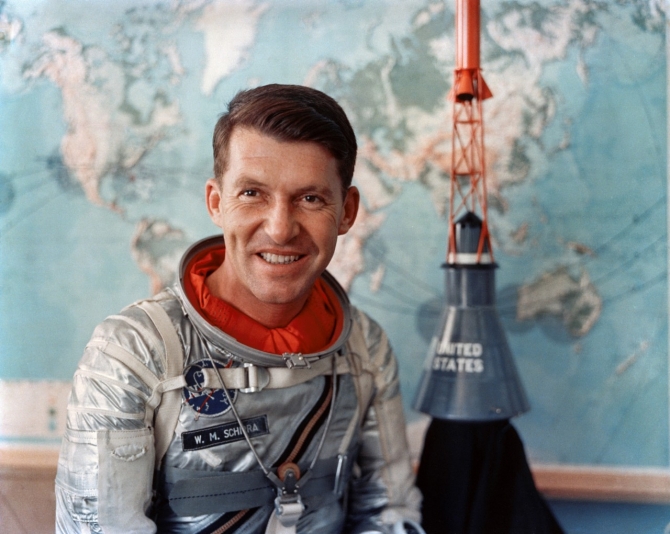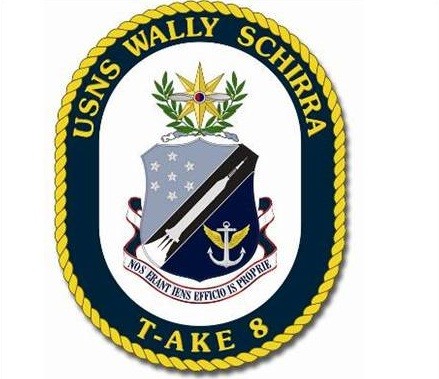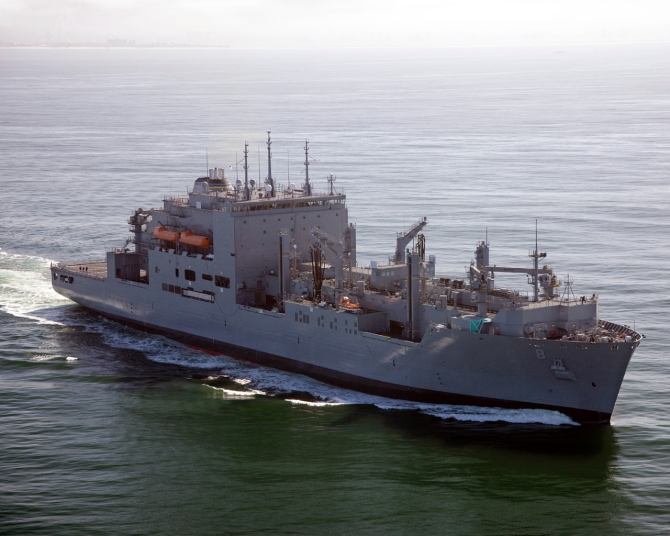Wally Schirra (T-AKE-8)
2009–
Walter Marty Schirra Jr. was born on 12 March 1923 in Hackensack, N.J., to Walter Marty [Sr.] and Florence S. Schirra. His father graduated from Columbia University with an engineering degree and completed flight training with the British Royal Air Force in Canada. The elder Schirra was then commissioned as a second lieutenant in the U.S. Army Signal Corps, and flew bombing and reconnaissance missions against the Germans during World War I. Following the war, he barnstormed at county fairs around New Jersey as a stunt flier with his wife, who sometimes stood on the wing of his biplane.
Schirra graduated from Dwight W. Morrow High School in Englewood, N.J., in June 1940. He studied aeronautical engineering at the Newark College of Engineering (now the New Jersey Institute of Technology), 1940–42. He was then appointed to the U.S. Naval Academy at Annapolis, Md., and received a Bachelor of Science degree on 6 June 1945. Upon graduation, he was commissioned an ensign and ordered to sail on board large cruiser Alaska (CB-1) for Japanese waters, but the war ended before he saw action.
Schirra married Josephine C. Fraser of Seattle, Wash., on 23 February 1946. She was the step-daughter of Adm. James L. Holloway, Assistant Chief of Naval Personnel for Demobilization. Their union produced two children: Walter M., III, and Suzanne K. Schirra subsequently served on the staff of the Seventh Fleet. He completed pilot’s training at Naval Air Station Pensacola, Fla., and was designated a naval aviator in 1948. Schirra flew initially with Fighter Squadron (VF) 71. As an exchange pilot with the USAF’s 154th Fighter Bomber Squadron during the Korean War, he flew 90 combat missions in Republic F-84E Thunderjets, mainly low-level bombing and strafing. He received credit for shooting down an enemy Mikoyan and Gurevich (MiG) jet with gunfire on 23 October 1951.
He returned from the war and served as a test pilot at Naval Ordnance Training Station, China Lake, Calif. (1952–54), where he took part in the development of the AIM-9 Sidewinder air-to-air missile. During a test flight, he launched a Sidewinder and the missile doubled back in the direction of his jet, but he skillfully evaded the errant weapon. Schirra next flew as a project pilot for the Vought F7U-3 Cutlass, and as an instructor pilot on the Cutlass and the North American FJ-3 Fury (1954–56). He then flew McDonnell F3H-2N Demons as the operations officer of VF-124 on board antisubmarine warfare support aircraft carrier Lexington (CVS-16) in the Pacific (1956–57). Schirra attended the Naval Air Safety Officer School at the University of Southern California, and then (1958–59) completed test pilot’s training at the Naval Air Test Center at Patuxent River, Md. He took part in suitability development work on the McDonnell Douglas F-4H Phantom II while at Patuxent River.
At Patuxent River, Schirra also learned of Project Mercury, a basic program in the development of space exploration and manned orbital flight. He later recalled that being an astronaut did not interest him at first, but that he warmed to the idea as he heard more about the program. Doctors at the Lovelace Clinic in Albuquerque, N.M., tested him for a position as an astronaut but discovered a polyp on his larynx. The surgeons offered to remove the polyp, however, the treatment included absolute silence for four days, and he was scheduled to take some psychological tests that required speaking, in Dayton, Ohio. In addition, he had to consult with his commanding officers, but the medical staff subsequently put him on a week’s silent treatment. A National Aeronautics and Space Administration (NASA) official called Schirra from Langley Research Center at Hampton, Va., and inquired about the status of his polyp, thus requiring him to break his silence at one point. At the end of the week the doctors decided to operate immediately, but when they arranged for a two or three month treatment in two to three days, their speed tipped Schirra to his likely selection for the program.
NASA announced the selection of seven prospective astronauts including naval aviators Lt. Col. John H. Glenn, USMC, Lieutenant Commanders Schirra and Alan B. Shepard, Jr., and Lt. Malcolm S. Carpenter to Project Mercury, on 7 April 1959. Schirra’s special responsibility was the development of environmental controls (life-support systems) to ensure the safety and comfort of the astronaut within the spacecraft during the mission. He also worked on the testing and improvement of their pressurized suits.

He served as the backup pilot for Mercury-Atlas-7, the three orbit mission that Carpenter flew, on 24 May 1962. On 27 June, Schirra was designated for the fifth manned space mission and third orbital flight, originally scheduled for 28 September but delayed because of a malfunctioning fuel-control valve. Cmdr. Schirra named his space capsule Sigma 7, because the name symbolized engineering precision. He piloted Sigma 7 during the launch of Mercury-Atlas-8 from Cape Canaveral, Fla., on 3 October. Schirra completed an orbit of 9 hours, 13 minutes, and 11 seconds, and splashed down in the Pacific 275 miles northeast of Midway Island near 32°5'N, 174°28'W, and about 9,000 yards from primary recovery ship Kearsarge (CVS-33). Helicopters dropped swimmers near the capsule and Kearsarge hoisted Sigma 7 and Schirra on board the carrier. Schirra received his astronaut wings on 16 October.
After Project Mercury, Schirra worked with the other astronauts and with NASA officials, scientists, and engineers in the development of Project Gemini, the intermediate stage between the Mercury program and the Apollo Moon project. He served as the backup command pilot for Gemini-Titan-III, containing space capsule Molly Brown, crewed by Maj. Virgil I. Grissom, USAF, and Lt. Cmdr. John W. Young (23 March 1965).
Schirra was next supposed to hurtle into space, with Maj. Thomas P. Stafford, USAF, as part of Gemini-Titan-VI on 25 October 1965. NASA intended for their mission to perform the first rendezvous and docking between different spacecraft, a vital prerequisite for voyages to the moon. The agency scrubbed the mission, however, because of the catastrophic failure of the Gemini Agena 5002 target vehicle. Schirra’s second spaceflight thus began on 15 December 1965, when he launched as the command pilot on board Gemini-Titan-VIA from John F. Kennedy Space Center. They completed a non-docking orbital rendezvous with Gemini-Titan-VII, which had launched on 4 December, crewed by Lt. Col. Frank Borman, USAF, and Cmdr. James A. Lovell Jr. After 16 orbits of 25 hours, 51 minutes, and 24 seconds, Gemini-Titan-VIA splashed down in the Western Atlantic about 300 miles north of Puerto Rico, near 23°42'N, 67°48'W, within seven miles of primary recovery ship Wasp (CVS-18), on 16 December. Schirra and Stafford remained within the capsule, and Sikorsky SH-3A Sea Kings of Helicopter Antisubmarine Squadron (HS) 11 recovered the astronauts and their spacecraft and delivered them to Wasp.
He was then assigned to the prime crew for the second manned Apollo flight, on 29 September 1966. Schirra served as the backup commander for Apollo 1 (204), scheduled to launch on 21 February 1967. A fire swept through Command and Service Module 012, however, during a simulated launch of the first manned Apollo space flight atop her Saturn IB launch vehicle at John F. Kennedy Space Center, on 27 January. The blaze killed all three crewmen: Lieutenant Colonels Virgil I. Grissom, USAF, and Edward H. White, II, USAF, and Lt. Cmdr. Roger B. Chaffee. NASA’s Apollo 204 Review Board did not discover evidence that suggested sabotage or a single ignition source of the fire, but determined that the most probable initiator resulted from a momentary power failure in the area of an electrical arc in the sector between the -Y and +Z spacecraft axes. Grissom and Chaffee were buried in the National Cemetery, Arlington, Va., and White at the U.S. Military Academy, West Point, N.Y., on 31 January. Schirra was reassigned to the prime crew for the first manned Apollo flight on 9 May.
Schirra began his third and final mission when he launched with Lt. Col. Donn F. Eisele, USAF, and Maj. R. Walter Cunningham, USMCR, in Apollo 7, the first manned Apollo flight from John F. Kennedy Space Center, on 11 October 1968. All three astronauts developed head colds during their almost 11 days in space. Approximately 15 hours into the flight, Schirra developed a severe cold, and Cunningham and Eisele soon followed suit. Their mucus accumulated in the weightlessness of space, and failed to drain. The men could not seek relief by blowing their noses, because the action hurt their eardrums. Apollo 7 nonetheless accomplished all the primary mission objectives, and on 14 October the astronauts made the first live TV broadcast from a manned U.S. spacecraft. Several days before the mission ended, however, they began to worry about wearing their suit helmets during reentry; because that would prevent them from blowing their noses, and NASA doctors feared that the buildup of pressure might burst their eardrums. Mission Control therefore attempted to persuade them to wear the helmets, but Schirra contested their impassioned directives. The astronauts each took an Actifed decongestant an hour before reentry, and passed through the acceleration zone without experiencing additional audio problems. After 163 orbits over 10 days and 20 hours, the spacecraft splashed down in the Atlantic about 285 miles south of Bermuda, and approximately eight miles from primary recovery ship Essex (CVS-9), on 22 October. Helicopters of HS-5 operating from Essex returned the astronauts to the carrier. Schirra became the only Mercury astronaut to fly on board Mercury, Gemini, and Apollo spacecraft.
He retired from the Navy as a captain and resigned from NASA on 1 July 1969. Schirra then became president of Regency Investors, Inc., a financial complex and global leasing company based in Denver, Colo. He served as chairman and chief executive officer of Environmental Control Co., based in Englewood, Colo., 1970–1973. From 1973 to 1974, he was chairman of the board of SERNCO, Inc., and for the next three years a director at Johns-Manville Corp., in Denver, Colo. He worked as vice president for development at Goodwin Companies, Inc., in Littleton, Colo. (1978–1979).
In January 1979, he formed his own firm, Schirra Enterprises, and worked as an independent consultant the following two years. In 1980, he was elected to the board of directors of Electromedics Inc. He also served as president of Prometheus, an energy development company in Colorado, and on the board of directors of Kimberly Clark, Finalco, and Net Air Intl. Schirra joined with the other surviving Mercury astronauts and Grissom’s widow, Betty L. Grissom, and founded the Mercury Seven Foundation to raise money for scholarships for science and engineering students in college, in 1984 (In 1995, the organization was renamed the Astronaut Scholarship Foundation). Schirra subsequently worked as a private consultant in Rancho Santa Fe, Calif., a public speaker, and a television commercial spokesman for Actifed.
Schirra died on 3 May 2007 died at the age of 84, from a heart attack due to malignant mesothelioma, at Scripps Green Hospital at La Jolla, Calif. Schirra was a “dear friend, cherished comrade and a brother,” fellow Mercury astronaut Carpenter recalled. “Despite our good natured competition for flights into space,” he reflected, “Wally strove to bring a smile to everyone he met and it’s with a smile that I will forever fondly remember him.” President George W. Bush also mourned Schirra’s passing. “His ventures into space furthered our understanding of manned space flight and helped pave the way for mankind’s first journey to the Moon,” the President said. “Laura and I join Wally's family and friends and the NASA community in mourning the loss of an American hero.”
A memorial service was held at Fort Rosecrans National Cemetery, Calif., on 22 May. Sailors committed the ashes of nine Navy veterans including Schirra to the Pacific during a ceremony on board aircraft carrier Ronald Reagan (CVN-76) on 11 February 2008. His awards include: three Distinguished Flying Crosses; two NASA Distinguished Service Medals; two NASA Exceptional Service Medals; the Navy Distinguished Service Medal; and Navy Astronaut Wings. He held an honorary Doctorate of Astronautical Engineering from Lafayette College, Pa.; an honorary Doctorate of Astronautics from the Newark College of Engineering, N.J.; and an honorary Doctorate of Science from the University of Southern California. He was a fellow in the American Astronautical Society and the Society of Experimental Test Pilots; a member of the American Institute of Aeronautics and Astronautics and American Fighter Pilots Association; and a 33d Degree Mason. Schirra was inducted into the National Aviation Hall of Fame in Dayton on 26 July 1986.
(T-AKE 8: displacement 42,528; length 689'; beam 106'; draft 30'; speed 20 knots; complement 197; armament up to 6 .50 caliber or 7.62 millimeter machine guns, aircraft 2 Sikorsky MH-60S Knighthawks or 2 Eurocopter (Aérospatiale) AS332 Super Pumas; cl. Lewis and Clark)
Wally Schirra (T-AKE 8) was laid down on 14 April 2008 at San Diego, Calif., by General Dynamics National Steel and Shipbuilding Co.; launched on 8 March 2009; sponsored by Mrs. Josephine C. Schirra, the late Capt. Schirra’s widow; and was placed in service with the Military Sealift Command on 1 September 2009.

Shield
The shield is adopted from the seal of the state of New Jersey, Schirra’s birthplace. The light blue field and stars in the orbit pattern represent his position in history as one of the original seven Project Mercury astronauts. The dark blue background suggests the sea, which personifies Schirra’s naval career. The winged anchor represents his profession as a naval aviator. The angled rocket and background signifies force; with black symbolizing space and reflecting his career as an astronaut. The Mercury rocket illustrates Schirra’s journey into space, and his experience as the only astronaut to fly in all three of the original manned space programs: Mercury, Gemini, and Apollo.
Crest
The laurel represents honor and achievement. The compass rose denotes Wally Schirra’s navigational capabilities to accomplish her mission of transporting supplies and dry goods to the fleet. The biplane propeller alludes to his birth into an aviation family; his father worked as a barnstormer and his mother a performer of aerial displays. The spinner of the propeller is in the colors of the Ticino valley in the Italian speaking portion of Switzerland, and the origin of the Schirra name.

Detailed history under construction.
Mark L. Evans
12 March 2014


